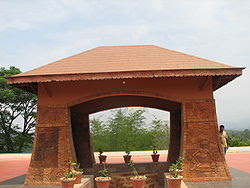
The next morning, their leader, Kerala Varma, was up early. It was an important day for him, his mother's death anniversary. He bathed in the Mavila Thodu, and finished his prayers. He discussed strategy with his men for a while, and then they formed a protective circle around him as he sat on the bank and the ceremonies began. Suddenly, in the middle of the rituals, they found themselves surrounded by the English army under Sub-Collector Thomas Harvey Baber.
Bullets were fired and the men scattered. His men pleaded with Kerala Varma to escape, but he refused. In the ensuing confusion, a bullet caught him in the chest. With a prayer to Sriporkali, the goddess of Pazhassi, he collapsed on the bank. His men stood helpless, watching the end of their only hope of freedom.
Ingenious tactics
The story of Pazhassi Raja Kerala Varma isn't well known outside Kerala, but he was one of our country's first freedom fighters. He had to reckon with the armies of the Mysore rulers as well as the British. The British first used him against Tipu's army and then reneged on their treaty, coming in to usurp the land. He was forced to flee his palace in Kottayam with a band of trusted followers and spent the rest of his days in the treacherous Wayanad jungles, refusing to give up, and inflicting grave and humiliating injuries on the British. His survival depended on the loyalty and resilience of his subjects under British pressure and the ingenuous strategies he employed to evade and attack the enemy. Using guerrilla tactics and informers, he kept the British on tenterhooks for longer than any other regional ruler. When the British brought out their trump card, Colonel Arthur Wellesley, the strategy worked and ended in the death, if not capture, of the royal rebel.Pazhassi Raja Kerala Varma was exposed to warfare from his early teens. Many of his family members and several well-placed Nair families fled south because of local skirmishes and confrontations with Hyder Ali. But Kerala Varma stayed on in Pazhassi, determined to face the invaders, protect his people and remain close to the family deity, Sriporkali. Pazhassi's first revolt against the British began in 1793. The people were unhappy over the tax collections and the neglect of their welfare. The British selected a pliable administrator for Kottayam, ignoring Kerala Varma's claim, and gave him complete authority. The move was so blatant that even some British reports questioned its wisdom.
Uncanny knowledge
The British soon realised that they were up against a formidable enemy in Kerala Varma. Even when his palace was ransacked and he had to seek refuge in the mountains, he continued to frustrate their efforts with his guerrilla tactics. With the help of tribals and an uncanny knowledge of the treacherous jungles, he and his men indulged in cat-and-mouse games that depleted the strength of the British forces, and soon their single-point agenda was to claim the Raja's head. They accomplished this by befriending a dependant of Kerala Varma, a man who had come to him as a boy on the brink of starvation and grown up under his care. This man, Pazhayaveettil Chandu, knew the Raja and his hiding place intimately, and had no qualms about sharing his knowledge with the British. Kerala Varma was devastated by this betrayal. Even as they moved away to the Mysore side of the forest, they all sensed that the end was imminent.
There are no contemporary portraits of Kerala Varma that show his likeness, but word-pictures remain. Walter Ivor, a member of the former British Court of Directors, happened to be present during a discussion before the first peace treaty with Kerala Varma was signed. He describes a small man with a smile. His followers seemed to love and respect him greatly. Later, the Governor, Jonathan Duncan, who met the Raja in the Tellicherry Fort, had this to say about him: "Pazhassi Raja had long hair and a short thick beard, and was a small man. Sometimes he was in the habit of wearing a red cap. His face radiated a great glow."
His nemesis, Baber, was an energetic young man, reputed to be purposeful and correct. He made sure that people would see Pazhassi Raja's death as the death of a great king and not simply that of an enemy. He placed the body in his own palanquin, and the last rites were performed in a manner befitting a royal departure. Baber described the Raja as an "extraordinary and singular character".
Legend and history
British ranged from the idolatry to the acrimonious, and it was difficult to isolate the historical facts. The British had razed the original palace to the ground and built a road over it. Now there was this flat square piece of land beside the road and an ancient pond which, presumably, had been witness to many of the bloody goings-on.

 Pazhassi Raja an artist's view on a latterite wall
Pazhassi Raja an artist's view on a latterite wall

